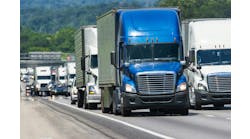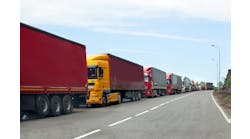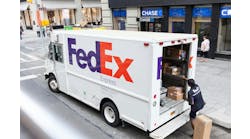It's hardly news to the industry that diesel engines have to meet stringent emission requirements by 2007. In 1970, the Clean Air Act (CAA) subjected on-highway diesel engine manufacturers to air pollution standards that mandated maximum allowable levels of emissions of carbon monoxide, hydrocarbons and nitrogen oxides (NOx). In the 1990's the program was expanded by the Environmental Protection-Agency (EPA) to include off-road diesels, which includes marine vessels and railroad locomotives.
Subsequent CAA amendments have become progressively tougher. Most recent standards were approved in December 2000. They now apply to heavy-duty highway engines and vehicles, and compliance must begin in 2007 and be fulfilled by 2010. Additionally, manufacturers of diesel fuel have to reduce sulfur levels in their products by mid-2006.
The aim of the CAA is simply to have cleaner air. No one in motor, truck or fuel manufacture, or as a purchaser and user of the new products, argues about the benefits of cleaner air. Something all agree on as well is that there are higher costs connected to improving the air, and in the area of transportation, these costs will be passed on to the shipping community.
As Allen Schaeffer, executive director of the Diesel Technology Forum, notes, "There is a desire on the part of EPA and others to make sure that this very important milestone in the history of clean diesel technology arrives in a very positive way, that environmental benefits are accrued, that the new technology gets out there, and people become comfortable with it."
That said, there remain a number of issues that must be resolved in order to make this technological transition work and work well.
Time and costs are two factors of concern to carriers and private fleet operators — in other words, those who are buying the engines and trucks and fuel to serve shippers' needs, and ultimately consumers' needs.
"We've been dealing with emission regulations since 1988," points out Steve Duley, vice president, purchasing, with truckload carrier Schneider National.
"Meeting regulations then wasn't that great an issue because suppliers did an outstanding job of keeping up with the technology and were always able to offer tradeoffs. Starting in October 2002, they seemed to reach a point of diminishing return where there was no longer balance of value with prices — emissions standards were so high and so difficult, it all became a big cost."
As Duley sees the situation, when the EPA accelerated the deadline, the new schedule took away development time for suppliers, adding high cost and high risk.
"If you wanted to buy a new truck," Duley notes, "you were buying something that was basically unproven. You were forced to take the risk of having breakdowns, with customer service issues and driver issues, in addition to all of the costs associated with those things."
Every engine manufacturer has publicly stated it will have technology available to meet the standards within the timeframe required by the government, Schaeffer points out. They all stated this unequivocally in public statements earlier this year.
"Engine manufacturers are investing, collectively, well over a $1 billion to meet these requirements, " Schaeffer says. "The fuel refining industry is investing as much or more. The fuel industry has been making substantial changes as well, and they also have some pretty stringent standards to meet in 2007."
Schneider is looking at incremental cost estimates of $15,000 per truck to meet the new standards. These figures are significantly different from those offered by EPA. These estimates were developed in 2002 and, according to Duley, no one has offered any statistics to shake these figures.
"We still stand by our estimate," Duley states. "We are a couple of years into it now, and those things that have happened already are pretty close to what we projected. Unfortunately, we seem to be on track to have a $15,000 incremental net present value cost over the life of the truck."
Another issue for Schneider is the availability of newer technology engines in trucks for them to test. A perception is that suppliers are testing their new engines in laboratories, and while most will have a few trucks on the highway for testing, they will be under the control of the manufacturer.
"Our primary supplier is saying it will be late 2005 before we really get to work with the new engines in trucks," claims Duley. "So a decent evaluation period is somewhat up in the air. We were planning on entering 2007 with a very new fleet. Whether you call it pre-buying or just accelerating our purchases, starting in 2005 and 2006, we planned on buying quite a few more trucks than normal."
The problem as Duley sees it is the carriers aren't necessarily buying the 2007 technology, since no one is quite sure yet what the 2007 technology is going to be.
"We think it's going to be very expensive," Duley notes, "so we want to make sure we have time to really understand the 2007 requirements before we buy large quantities of trucks. One way we can do that is to enter 2007 with a very new fleet. We can buy small quantities and evaluate them, and delay having to do major purchases until we are sure what that 2007 engine will do."
Engine manufacturers are certainly very sensitive as to the issue of whether or not — in the minds of truckers — they will have adequate time to essentially beta test this technology before it's developed for final sale.
"These are very fundamental changes for the engine industry, and they are requiring a extraordinary level of research and development," notes Schaeffer. "In the past it was possible to have a long period of time for testing. That's going to be much more challenging this time because of how stringent standards are and the timeframe under which we're operating."
Refiners are well on the way to meeting the 2006 ultra low fuel sulfur requirements; however, the new fuel is more expensive. Conservative estimates are the new fuel will cost about five cents more per gallon, Duley notes. For Schneider that means about $1 million more in its annual fuel bill during the first year.
"Even if we don't buy a single 2007 engine," he says, "truck stops don't have the ability to carry both regular and low sulfur fuel so they will switch over fairly soon. We'll end up buying ultra low sulfur diesel and running it in the old technology engines, which don't require it. There's nothing bad about that; they'll run fine. But with fuel, 100% of our fleet is going to incur that cost no matter what we do."
Duley's remarks echo the same concerns that all trucking carriers share. "Schneider certainly is in favor of having cleaner air," he says, "and recognizes the long-term need to use diesel engines until there's a better technology — if there ever is one. We understand we need to cooperate and even lead, as best we can, to make sure the engines are running as clean as they can."
As Schaeffer notes, "The industry and manufacturers do have the best interests of their customers at heart and are certainly looking at ways to optimize things that matter to truckers: fuel economy, reliability, ease of maintenance, cost of operation. That's always been paramount. The challenge this time is that in the past it was always possible to deliver not only lower emissions but fuel economy, or one of those other attributes, as well. This time it's going to be much harder to do that because the level of getting clean is much tighter. It's a real balancing act for manufacturers to do that. "
As far as fuel producers, Schaeffer points to a recent EPA report noting that refiners are well on the way to meet 2006 low sulfur fuel requirements, and that the fuel will be available throughout the country as 95% of producers will be delivering the 15 parts per million limitation.
Schaeffer maintains an optimistic outlook. "We look to be standing next to truckers and fuel suppliers and engine makers on September 1, 2007 [the formal deadline], saying that today is a great day in America as it opens the next chapter for the diesel engine," he predicts.
| resources Diesel Technology Forum www.dieselforum.org Environmental Protection Agency www.epa.gov Schneider National www.schneider.com |
Cooling it for diesel engines
One technological challenge facing diesel engine manufacturers has been finding a way to reduce nitrogen oxides (NOx). As one manufacturer, Detroit Diesel Corp. (www.detroitdiesel.com), explains in its The ABC's of Exhaust Gas Recirculation (ERG), too much NOx in the atmosphere contributes to the production of smog. Since high cylinder temperatures — which make for a more efficient engine that delivers good performance and good fuel economy — cause NOx, reducing these temperatures can be accomplished by retarding ignition timing or lowering oxygen content in the cylinder which inhibits combustion.
While there are several methods of reducing oxygen in the cylinder, ERG has been chosen by Detroit Diesel and other manufacturers, such as Mercedes Benz Engines, Cummins, Volvo and Mack.
"Since the whole idea is to reduce cylinder temperatures, it's usually wise to cool the exhaust gas before putting it back into the cylinder," Detroit Diesel explains. "This approach is called 'cooled' ERG. ERG is so effective that it allows ignition timing to remain 'advanced,' improving performance and fuel economy and reducing soot."
After extensive research and evaluation, earlier this year Detroit Diesel announced its use of ERG and diesel particulate filters on its heavy duty engines in order to meet EPA 2007 emission requirements. Requirements are for reductions in 2007 of 50% in NOx emissions and 90% in particulate matter (PM). By 2010, EPA will require almost total elimination of these emissions. To meet those requirements, Detroit Diesel is examining a number of other technologies, including selective catalytic reduction.
Another manufacturer, Caterpillar (www.cat.com), uses a technology it terms ACERT (Advanced Combustion Emission Reduction Technology) for air management, to cool the combustion chamber, maintain engine efficiency and economize on fuel use. Made up of several components, Caterpillar electronics work to synchronize and harmonize all systems within ACERT technology.
Caterpillar's heavy-duty engines employ a series of turbochargers to force cool, clean air into the combustion chamber. The turbos work in series to improve responsiveness of the engine while lowering NOx and increasing fuel economy.
With the ACERT system, air volume needed to meet engine load and speed requirements is controlled by variable valve actuation. Within the engine valve actuation is precisely complimentary to the actuation of the camshaft.
Engines use proprietary Caterpillar electronically controlled unit injection fuel systems, and use split injection fuel delivery to the combustion chamber. The manufacturer explains that with split injection, a minute amount of fuel is injected at the beginning of combustion. This is the pilot injection. A millisecond later, a larger volume of fuel is used as the main injection. How much fuel is injected is determined by ACERT electronics.
ACERT technology includes exhaust after treatment, the Caterpillar Diesel Oxidation Catalyst (DOC). Within the exhaust system, as hydrocarbons, carbon monoxide and particulate matter pass through the DOC, they are chemically converted into carbon dioxide and water vapor, then passed out of the exhaust system.
Some additions and enhancements are part of ACERT engines designed to meet 2007 requirements. Jim Parker, vice president of Caterpillar Power Systems' marketing division, indicates that some 2007 engines at a variety of power ratings will be given to customers for testing in 2005. "It's important that our customers have the ability to assess the 2007 engines early on, to get the experience they need to make informed purchase decisions," he says.


